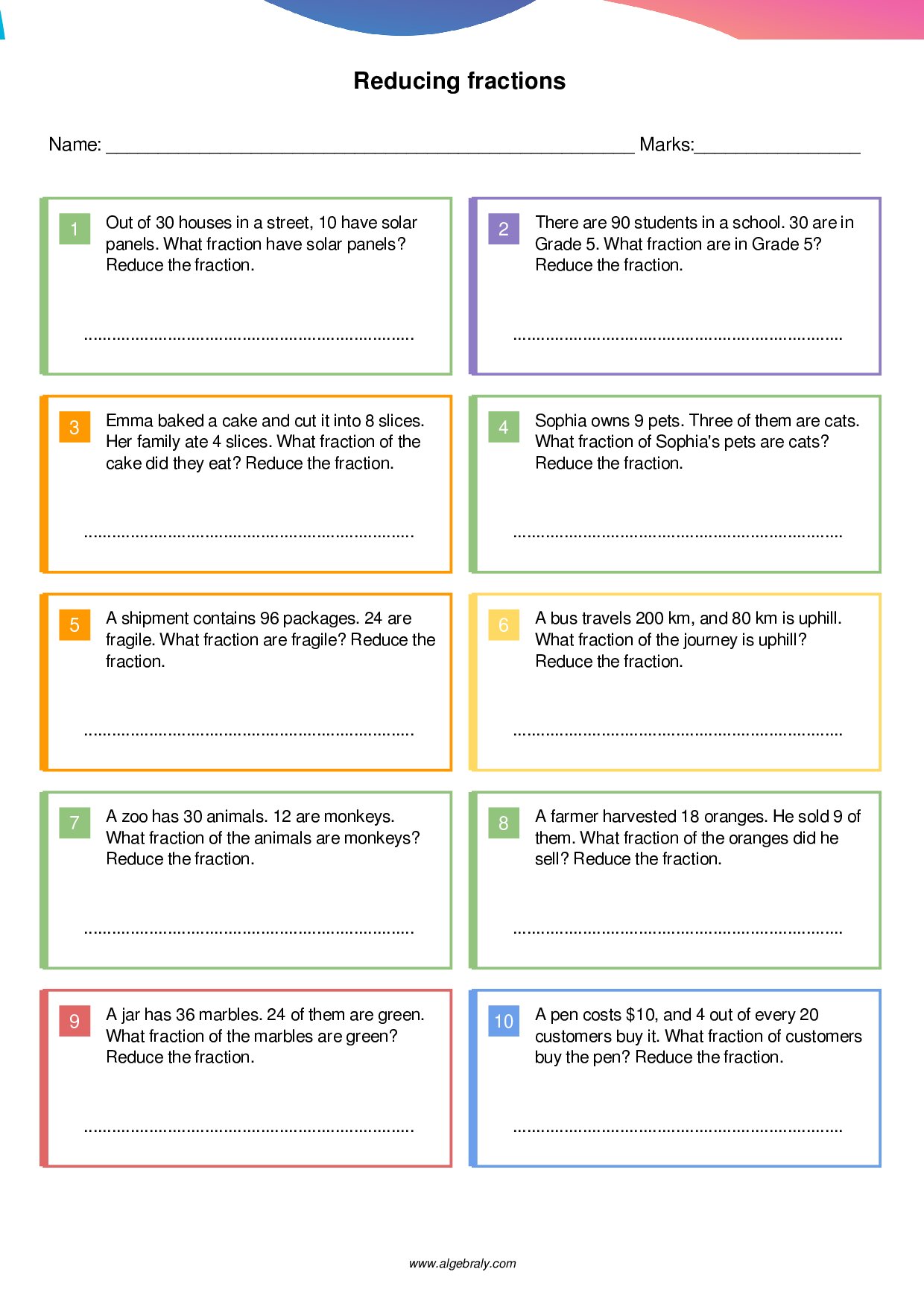Dynamically Generated Reducing Fractions Worksheets
Reducing Fractions Quiz
Out of 24 apples, 6 are green. What fraction of the apples are green?
Looking for an engaging way to help students to master fractions? These reducing fractions worksheets and online quiz are perfect tools for per-algebra learners! Designed with practicality in mind, these worksheets feature 15 interesting word problems each, focusing on real-world scenarios to make fractions relatable and fun. Teachers and parents can easily download these worksheets as printable PDF and use as flexible resource for classroom activities or at-home practice.
The online quiz allows students to test their skills interactively, providing immediate feedback to support learning. Important skills students should improve like fraction identification, fraction reduction, basic arithmetic, problem-solving, and critical thinking are focused from these worksheets and the online quiz. By solving these problems, students develop a deeper understanding of fractions, preparing them for advanced mathematical concepts.
You also can use worksheet generator that enabling you to create unique reducing fractions worksheets tailored to your students’ needs. Whether in the classroom or at home, this resource help students with the confidence to tackle fraction challenges effectively.
Skills Focused: Fraction identification, Fraction reduction, Problem-solving, Basic arithmetic, Critical thinking
How to Solve a Reducing Fractions Word Problem
Emma baked a cake and cut it into 8 slices. Her family ate 4 slices. What fraction of the cake did they eat?
Time needed: 1 minute
Learn how to reduce fractions step by step with an example problem about a cake.
- Write the fraction
Start by forming a fraction with the numerator representing the part eaten (4 slices) and the denominator representing the total slices (8 slices).
Fraction = 4/8 - Find the greatest common divisor (GCD)
Determine the GCD of 4 and 8, which is 4.
- Divide numerator and denominator by the GCD
Simplify the fraction by dividing both numerator and denominator by the GCD: 4 ÷ 4 = 1, 8 ÷ 4 = 2.
Simplified Fraction = 1/2 - Verify the answer
Multiply the numerator and denominator of the simplified fraction by 4 to confirm it matches the original fraction: 1 × 4 = 4, 2 × 4 = 8.
Verified that 4/8 = 1/2
Frequently Asked Questions (FAQs)
What does it mean to reduce a fraction?
Reducing a fraction means simplifying it to its lowest terms. This is done by dividing the numerator and denominator by their greatest common divisor (GCD).
For example, 4/8 simplifies to 1/2 because 4 is the GCD of both numbers.
Why is it important to simplify fractions?
Simplifying fractions makes the fractions easier to understand and compare. For example, 2/4 and 1/2 represent the same value, but 1/2 is simpler to read and work with in calculations.
How can you tell if a fraction is already simplified?
A fraction is simplified if the numerator and denominator have no common factors other than 1.
For example, 3/4 is simplified, but 6/8 is not because both numbers can be divided by 2.
What is the easiest way to simplify fractions?
The easiest way is to find the greatest common divisor (GCD) of the numerator and denominator and divide both by it. For instance, to simplify 8/12, divide both by their GCD, which is 4. The simplified fraction is 2/3.
Can improper fractions be simplified?
Yes, improper fractions can also be simplified. For example, 10/8 simplifies to 5/4. If needed, improper fractions can also be converted into mixed numbers.
What’s the difference between simplifying and reducing fractions?
There’s no difference! Simplifying and reducing fractions are two terms that mean the same thing—writing a fraction in its simplest form.
How do you simplify fractions with large numbers?
To simplify large numbers, find their greatest common divisor (GCD) using methods like prime factorization or the Euclidean algorithm. Divide both the numerator and denominator by the GCD to reduce the fraction.
What are some examples of simplified fractions?
Here are a few examples:
– 6/12 simplifies to 1/2.
– 15/20 simplifies to 3/4.
– 100/25 simplifies to 4/1 or just 4.
How can students practice simplifying fractions?
Students can practice with worksheets containing real-world word problems or take online quizzes for instant feedback. Both help reinforce the skill of reducing fractions.
Are there any shortcuts to reducing fractions?
A great shortcut is checking divisibility rules. For example, if both numbers are even, divide them by 2 repeatedly until you can’t anymore. This method quickly leads to the simplest form.
Can mixed numbers be reduced?
Yes, but first, convert the mixed number to an improper fraction. Simplify the improper fraction, and if needed, convert it back to a mixed number.
Why do we divide by the greatest common divisor (GCD) when reducing fractions?
Dividing by the GCD ensures the fraction is simplified in one step, as it removes all common factors between the numerator and denominator.
What’s a real-life example of reducing fractions?
Imagine a pizza cut into 8 slices, and 4 are eaten. The fraction 4/8 simplifies to 1/2, meaning half the pizza was eaten.
What’s the first step to simplify fractions?
Identify the greatest common divisor (GCD) of the numerator and denominator. Divide both by this number to simplify.
How do you teach students to simplify fractions effectively?
Use real-life examples, visual aids like pie charts, and interactive quizzes. Practice worksheets with step-by-step solutions also help build confidence and understanding.





